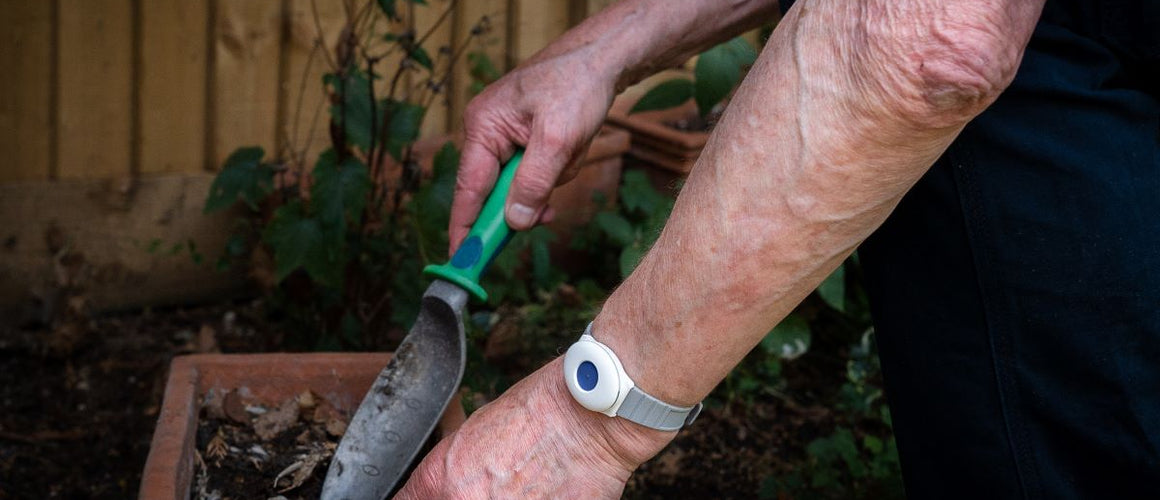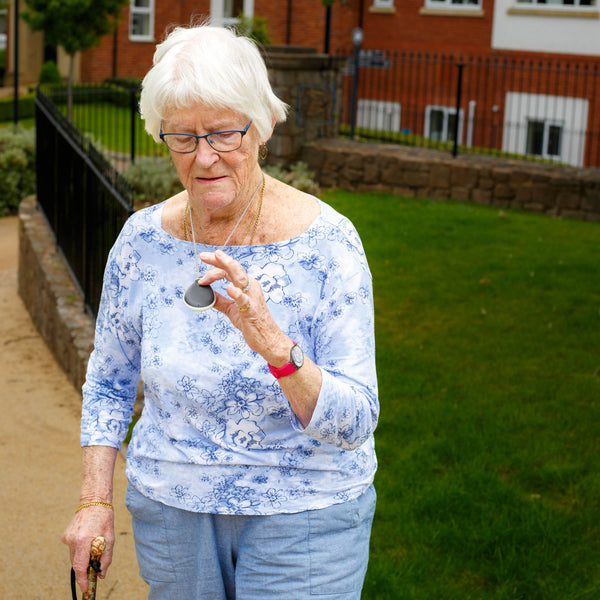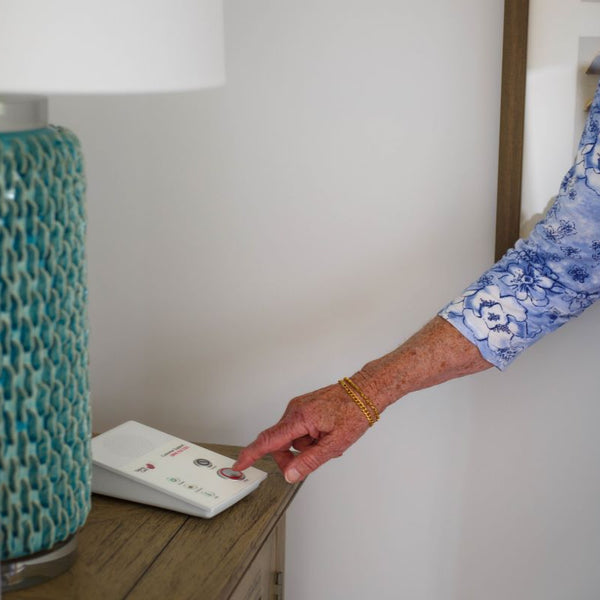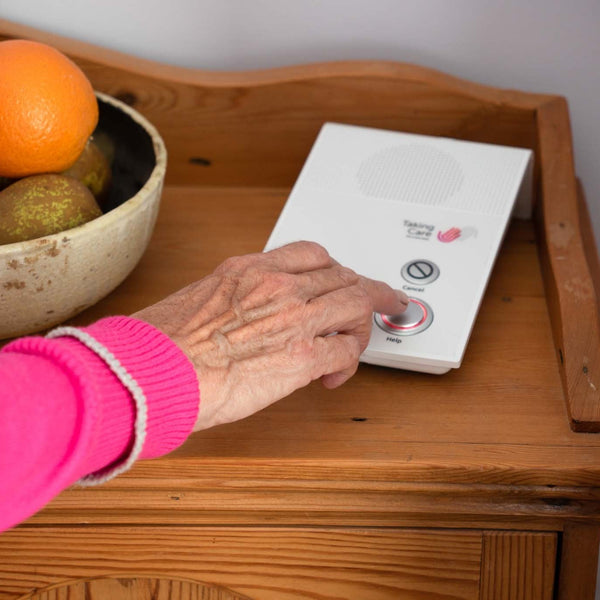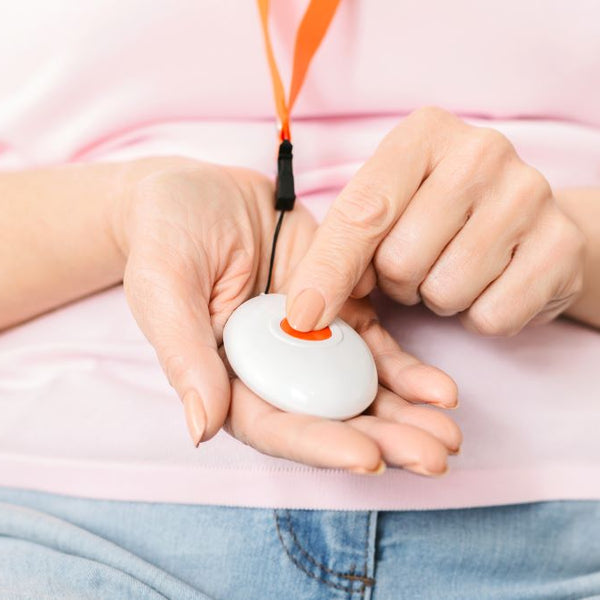It’s never been easier to help older adults or vulnerable individuals living on their own stay safe, connected, and independent. Thanks to advancements in tech, cellular alarm monitoring (such as 4G personal alarms) gives the elderly and their families some much-needed peace of mind by providing a way to call for help at home and when out and about.
In this blog, we’ll break down what alarm monitoring is, how it works, what makes it different from other alarms and the key features to look out for.
Jump to:
- What is cellular alarm monitoring?
- The benefits of 4G personal alarms vs traditional alarms
- How does cellular alarm monitoring work?
- How cellular monitoring alarm systems help the elderly live independently
- How to choose the right cellular monitoring alarm system
What is cellular alarm monitoring?
Cellular alarm monitoring is a reliable way to keep you or your loved ones safe and connected when it matters most. These alarms send an alert using the mobile network, just like your phone. Unlike traditional alarms that use an analogue telephone landline, cellular alarms use a SIM card to stay connected. So you can rely on them to work during power cuts or internet outages. Cellular alarms are also commonly known as digital personal alarms.
There is a difference between sensors that use LPWAN (Low-Power Wide-Area Network) technology and alarms that rely on cellular networks via a SIM card. LPWAN sensors are designed for ultra-low power use and long-range communication, ideal for battery-powered devices like motion detectors, door sensors and home monitoring solutions like Taking Care Sense.

Taking Care Sense device
Sensors that use a Low-Power Wide-Area Network typically send small data packets infrequently and connect to a private or shared IoT network. In contrast, cellular alarm systems operate more like mobile phones; they use a SIM card to connect to a 3G, 4G or 5G mobile network (which is why they are sometimes called 4G personal alarms or 5G personal alarms), enabling alerts to be sent directly to monitoring centres or your smartphone, even if your broadband or landline goes down.
The benefits of 4G personal alarms vs traditional alarms
If you’re caring for an elderly or a vulnerable loved one, knowing they can quickly get help is priceless - especially if you don’t live nearby. Cellular alarm monitoring systems are designed to give support to the elderly when they need it, and friends and family the reassurance that all is well.
Here’s why alarm system cellular monitoring might be a great fit for you or your loved one:
Always reliable
Cellular alarm monitoring systems are highly reliable because they continue to function even during power outages or when the internet is unavailable. This means the system stays operational, no matter the circumstances. Cellular alarms connect automatically to the strongest available mobile network. If one mobile network is down, the alarm will switch to a different network.
Future proof
BT have announced that by 2027 all analogue phone lines will be replaced with digital ones. If you have other equipment connected to the phone line, such as a personal alarm, then these may be affected by the upgrade. Cellular alarms are unaffected by the digital switchover because they do not use a telephone landline.
Reliable anywhere
4G personal alarms have excellent coverage, even in rural areas where mobile signals may be weak. This is because they are pre-fitted with multi-network SIM cards that connect to whichever mobile network is strongest. Often customers find their cellular alarm will work where they have poor mobile signal because the internal antenna in an alarm provides a stronger signal than a mobile phone.
Easy to set up
Digital or cellular alarm systems can be set up in minutes. Some have a voice-guided setup whilst others are ready to use right out of the box, hassle-free.
Choice of GPS enabled or in-home only
Some cellular alarm systems have a base unit, which unlike a traditional analogue alarm, does not need to be connected to a phone line. This means you have more flexibility where the base unit is placed in the home. Other cellular alarms are GPS-enabled and will work at home and out-and-about and do not need a base unit.
How does cellular alarm monitoring work?
Here’s how a cellular alarm monitor from Taking Care works:
1. The user wears a personal alarm
The elderly person wears or carries a personal alarm such as a pendant or wristband. The device includes a built-in SIM card that connects to the mobile (cellular) network, just like a mobile phone.
2. An alert is triggered
When the wearer presses the emergency button, a call is made to the 24-hour Emergency Resolution Team. Some alarms include fall detection and will automatically make a call when the pendant detects the wearer has fallen.
3. The alert is sent
The alert gets sent through the cellular network (usually 4G or sometimes 3G or 5G) straight to our Emergency Resolution Team. The alarm doesn’t need Wi-Fi or a landline to work.
4. The situation is assessed
Our trained emergency resolution team will speak with you directly through the alarm to give reassurance and figure out what kind of help is needed.
5. Help is on the way
We’ll call emergency services or a trusted contact to make sure they get help quickly and stay on the line to reassure them until it arrives.
How cellular monitoring alarm systems help the elderly live independently

When older family members or those with health issues want to live independently, it’s normal to worry about their safety. What if they fall? What if there’s a health issue or they need help when you’re not around? These worries can be a lot to handle.
That’s where cellular alarm monitoring comes in. It’s a reliable way to help them stay independent while knowing help is always just a call away.
Extra features to keep loved ones safe
Today’s cellular alarm monitoring systems come with features specially designed for vulnerable individuals. These extras can make a big difference, adding more security while still respecting their privacy.
Wearable personal alarms
Lightweight pendants, designed to be worn as a necklace or on a wristband like a watch, give users an easy way to call for help in emergencies. With just the press of a button, these handy devices can quickly alert others when assistance is needed.
Fall detection technology
Advanced sensors can automatically detect if the wearer has a fall and raise an alert without them needing to press the button. This ensures help is on the way even if the user is unconscious or unable to move.
GPS location tracking
Ideal for more active users, GPS-enabled alarms can pinpoint the wearer’s exact location, which is especially useful if help is needed away from home or in unfamiliar places.
Two-way communication
Built-in speakers and microphones allow users to speak directly with the Emergency Resolution Team through the alarm itself, offering reassurance and clear communication during emergencies.
Water-resistant design
Many 4G personal alarms are water-resistant, meaning they can be worn in the shower or bathroom, places where falls are more likely to occur, without needing to be removed.
How to choose the right cellular monitoring alarm system
Selecting the perfect monitoring system can feel daunting, but focusing on the key features makes the process much simpler. It can help to ask yourself these questions:
-
Can I wear it as a watch or necklace?
-
Will it work if I have a fall and can’t press the button?
-
How quickly will someone respond if I press the button?
-
Does it include GPS tracking for use away from home?
-
How long does the battery last, and how do I charge it?
-
Is it water-resistant?
Focus on the features that matter most to you, and you’ll find a system that fits your needs and gives you that all-important peace of mind.
At Taking Care, we’re committed to helping older adults live confidently and independently with our range of personal alarms and home monitoring.
Compare personal alarms online or if you’d like to speak with a member of our friendly team, give us a call at 0800 085 7371. We’re available Monday to Friday, from 9am to 6pm.
